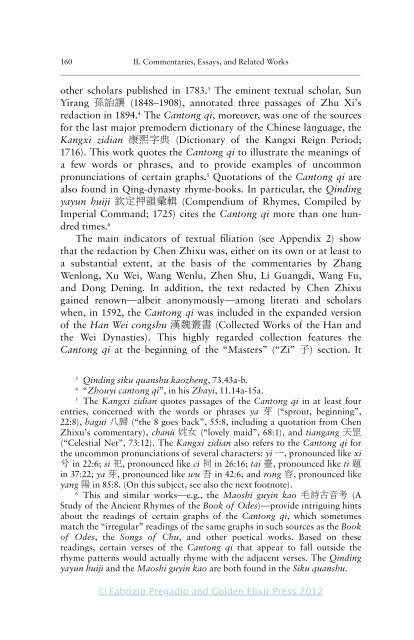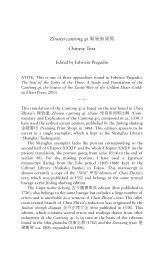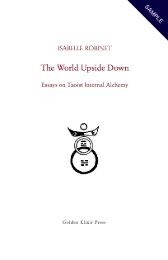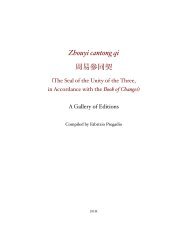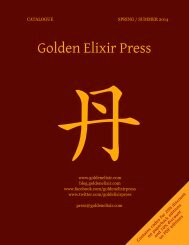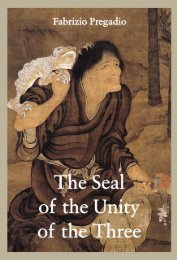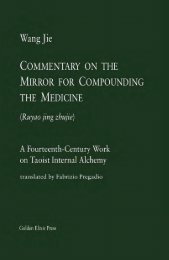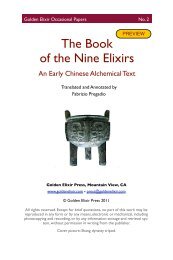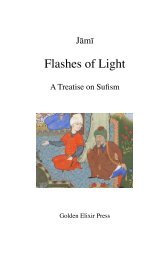The Seal of the Unity of the Three â Vol. 2 - The Golden Elixir
The Seal of the Unity of the Three â Vol. 2 - The Golden Elixir
The Seal of the Unity of the Three â Vol. 2 - The Golden Elixir
- No tags were found...
Create successful ePaper yourself
Turn your PDF publications into a flip-book with our unique Google optimized e-Paper software.
160 II. Commentaries, Essays, and Related Works<br />
—————————————————————————————————————————<br />
o<strong>the</strong>r scholars published in 1783. 3 <strong>The</strong> eminent textual scholar, Sun<br />
Yirang 孫 詒 讓 (1848–1908), annotated three passages <strong>of</strong> Zhu Xi’s<br />
redaction in 1894. 4 <strong>The</strong> Cantong qi, moreover, was one <strong>of</strong> <strong>the</strong> sources<br />
for <strong>the</strong> last major premodern dictionary <strong>of</strong> <strong>the</strong> Chinese language, <strong>the</strong><br />
Kangxi zidian 康 熙 字 典 (Dictionary <strong>of</strong> <strong>the</strong> Kangxi Reign Period;<br />
1716). This work quotes <strong>the</strong> Cantong qi to illustrate <strong>the</strong> meanings <strong>of</strong><br />
a few words or phrases, and to provide examples <strong>of</strong> uncommon<br />
pronunciations <strong>of</strong> certain graphs. 5 Quotations <strong>of</strong> <strong>the</strong> Cantong qi are<br />
also found in Qing-dynasty rhyme-books. In particular, <strong>the</strong> Qinding<br />
yayun huiji 欽 定 押 韻 彚 輯 (Compendium <strong>of</strong> Rhymes, Compiled by<br />
Imperial Command; 1725) cites <strong>the</strong> Cantong qi more than one hundred<br />
times. 6<br />
<strong>The</strong> main indicators <strong>of</strong> textual filiation (see Appendix 2) show<br />
that <strong>the</strong> redaction by Chen Zhixu was, ei<strong>the</strong>r on its own or at least to<br />
a substantial extent, at <strong>the</strong> basis <strong>of</strong> <strong>the</strong> commentaries by Zhang<br />
Wenlong, Xu Wei, Wang Wenlu, Zhen Shu, Li Guangdi, Wang Fu,<br />
and Dong Dening. In addition, <strong>the</strong> text redacted by Chen Zhixu<br />
gained renown—albeit anonymously—among literati and scholars<br />
when, in 1592, <strong>the</strong> Cantong qi was included in <strong>the</strong> expanded version<br />
<strong>of</strong> <strong>the</strong> Han Wei congshu 漢 魏 叢 書 (Collected Works <strong>of</strong> <strong>the</strong> Han and<br />
<strong>the</strong> Wei Dynasties). This highly regarded collection features <strong>the</strong><br />
Cantong qi at <strong>the</strong> beginning <strong>of</strong> <strong>the</strong> “Masters” (“Zi” 子 ) section. It<br />
3<br />
Qinding siku quanshu kaozheng, 73.43a-b.<br />
4<br />
“Zhouyi cantong qi”, in his Zhayi, 11.14a-15a.<br />
5<br />
<strong>The</strong> Kangxi zidian quotes passages <strong>of</strong> <strong>the</strong> Cantong qi in at least four<br />
entries, concerned with <strong>the</strong> words or phrases ya 芽 (“sprout, beginning”,<br />
22:8), bagui 八 歸 (“<strong>the</strong> 8 goes back”, 55:8, including a quotation from Chen<br />
Zhixu’s commentary), chanü 女 (“lovely maid”, 68:1), and tiangang 天 罡<br />
(“Celestial Net”, 73:12). <strong>The</strong> Kangxi zidian also refers to <strong>the</strong> Cantong qi for<br />
<strong>the</strong> uncommon pronunciations <strong>of</strong> several characters: yi 一 , pronounced like xi<br />
兮 in 22:6; si 祀 , pronounced like ci 祠 in 26:16; tai 臺 , pronounced like ti 題<br />
in 37:22; ya 芽 , pronounced like wu 吾 in 42:6; and rong 容 , pronounced like<br />
yang 陽 in 85:8. (On this subject, see also <strong>the</strong> next footnote).<br />
6<br />
This and similar works—e.g., <strong>the</strong> Maoshi guyin kao 毛 詩 古 音 考 (A<br />
Study <strong>of</strong> <strong>the</strong> Ancient Rhymes <strong>of</strong> <strong>the</strong> Book <strong>of</strong> Odes)—provide intriguing hints<br />
about <strong>the</strong> readings <strong>of</strong> certain graphs <strong>of</strong> <strong>the</strong> Cantong qi, which sometimes<br />
match <strong>the</strong> “irregular” readings <strong>of</strong> <strong>the</strong> same graphs in such sources as <strong>the</strong> Book<br />
<strong>of</strong> Odes, <strong>the</strong> Songs <strong>of</strong> Chu, and o<strong>the</strong>r poetical works. Based on <strong>the</strong>se<br />
readings, certain verses <strong>of</strong> <strong>the</strong> Cantong qi that appear to fall outside <strong>the</strong><br />
rhyme patterns would actually rhyme with <strong>the</strong> adjacent verses. <strong>The</strong> Qinding<br />
yayun huiji and <strong>the</strong> Maoshi guyin kao are both found in <strong>the</strong> Siku quanshu.<br />
© Fabrizio Pregadio and <strong>Golden</strong> <strong>Elixir</strong> Press 2012


